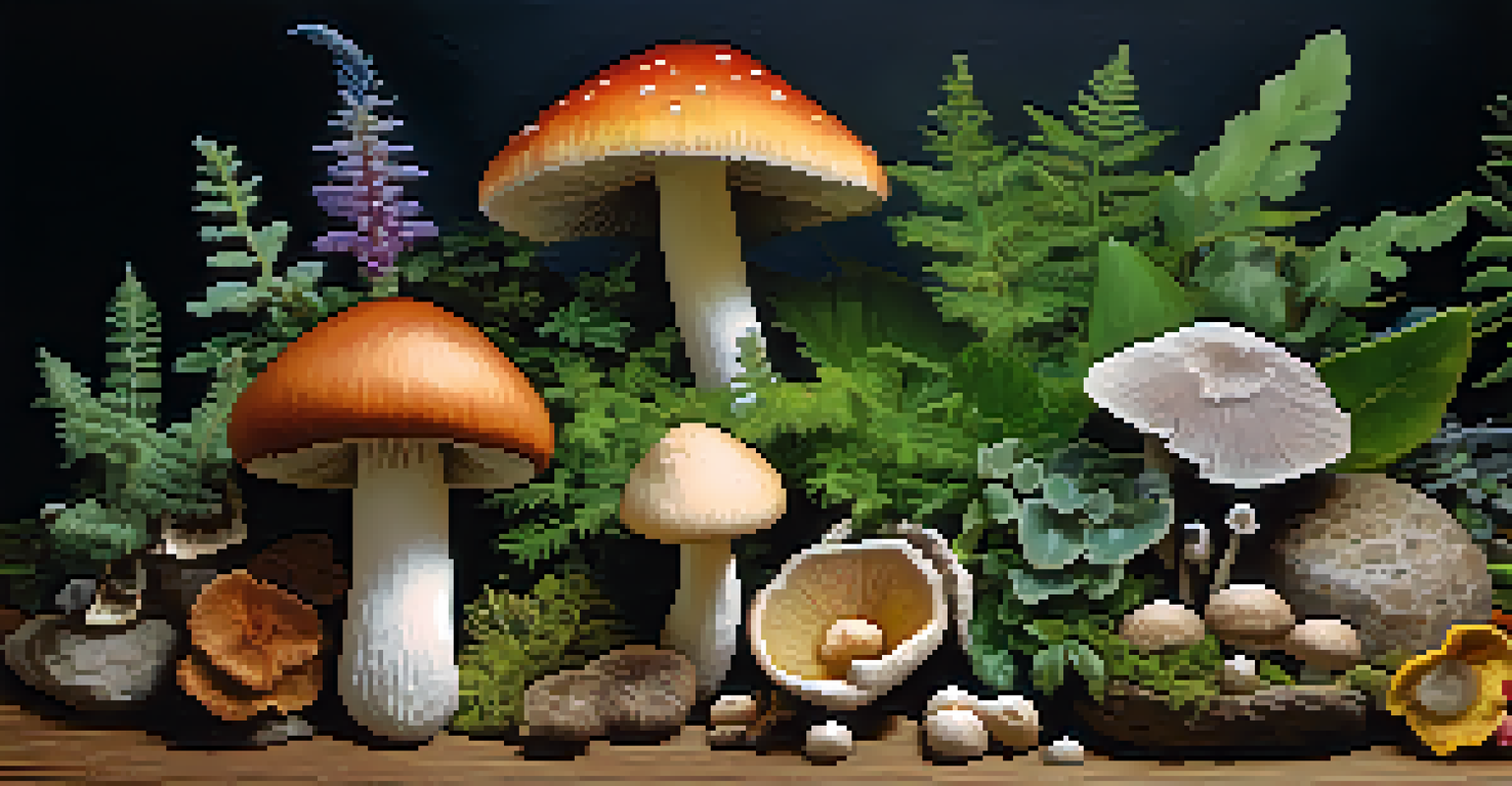Environmental Concerns in the Harvesting of Entheogens

Understanding Entheogens and Their Uses
Entheogens are natural substances that alter consciousness, often used in spiritual or therapeutic contexts. Common examples include psilocybin mushrooms and ayahuasca, which have gained popularity for their potential mental health benefits. As interest in these substances grows, so does the need to examine their environmental impact, particularly regarding harvesting practices.
The greatest threat to our planet is the belief that someone else will save it.
These plants and fungi are not just commodities; they are integral to the ecosystems where they thrive. When harvested sustainably, they can contribute to local economies and preserve cultural traditions. However, irresponsible harvesting can lead to ecological degradation, threatening both the species and the environments that depend on them.
Ultimately, understanding the role of entheogens in both human culture and the environment is crucial. This awareness can help inform better practices that honor both the plants and the people who rely on them. As we dive deeper into this topic, we’ll explore the specific environmental concerns associated with entheogen harvesting.
The Impact of Overharvesting on Biodiversity
Overharvesting is a significant threat to the biodiversity of regions where entheogens are found. When these plants are collected in excess, it can disrupt local ecosystems and lead to the decline of various species. For instance, certain types of mushrooms may take years to regenerate, and excessive picking can deplete their populations.

Moreover, the loss of these plants can have cascading effects on the entire ecosystem. Many entheogens are part of complex food webs, supporting insects, animals, and even other plants. When one part of this web is removed, it can create imbalance, affecting everything from soil health to animal populations.
Sustainable Harvesting is Crucial
Responsible harvesting practices are essential to protect biodiversity and ensure the longevity of entheogen species.
To combat these effects, sustainable harvesting methods must be adopted. This involves educating harvesters about responsible techniques and the importance of preserving local biodiversity. By doing so, we can help ensure that these valuable plants continue to thrive in their natural habitats.
Ecological Footprint of Entheogen Cultivation
As the demand for entheogens rises, many are turning to cultivation as a means of supply. While this can reduce pressure on wild populations, it often comes with its own set of environmental issues. For example, converting natural landscapes into farms can lead to habitat destruction and increased pollution from agricultural practices.
We do not inherit the earth from our ancestors, we borrow it from our children.
Additionally, the use of pesticides and fertilizers in cultivation can harm surrounding ecosystems. Chemical runoff can contaminate local waterways, affecting aquatic life and the health of nearby communities. This highlights the importance of adopting organic and eco-friendly farming practices when cultivating entheogens.
By prioritizing sustainable cultivation methods, we can minimize the ecological footprint of entheogen production. Techniques such as permaculture and agroforestry not only support healthy crops but also promote biodiversity and soil health. This way, we can strike a balance between supply and environmental stewardship.
Cultural Significance and Environmental Ethics
The harvesting of entheogens is often deeply intertwined with cultural practices and spiritual beliefs. Many indigenous communities have used these substances for centuries, seeing them as sacred gifts from nature. This cultural significance raises important ethical questions about the commodification of entheogens and the rights of local populations.
When external entities exploit these resources without regard for local customs, it can lead to cultural erosion and environmental harm. It's essential to recognize the voices of indigenous peoples in conversations about entheogen harvesting. They often possess valuable knowledge about sustainable practices that have been passed down through generations.
Cultural Significance Matters
The harvesting of entheogens is deeply connected to indigenous cultures, highlighting the need to respect their knowledge and rights.
By respecting cultural perspectives and integrating them into environmental policies, we can create more equitable and sustainable harvesting practices. This collaborative approach not only honors tradition but also fosters a greater understanding of our shared responsibility to protect the environment.
Regulatory Measures for Sustainable Harvesting
As awareness of environmental concerns in entheogen harvesting grows, so too does the need for effective regulatory measures. Governments and organizations can play a crucial role in establishing guidelines that promote sustainable practices. This includes creating legal frameworks that protect both the plants and the ecosystems they inhabit.
Regulations can also help ensure that local communities benefit from entheogen harvesting. By implementing fair trade practices and providing support for sustainable development, we can empower these communities to manage their resources responsibly. This not only protects the environment but also enhances the livelihoods of those who depend on these plants.
Collaboration between local communities, governments, and environmental organizations is key to developing effective regulations. By working together, we can create a balanced approach that prioritizes ecological health and cultural integrity in the harvesting of entheogens.
The Role of Education in Responsible Harvesting
Education is a powerful tool in promoting responsible harvesting of entheogens. By raising awareness about the ecological impact of harvesting practices, we can encourage more sustainable behaviors. Workshops, community programs, and online resources can all serve as platforms for sharing knowledge about best practices.
Harvesters who understand the importance of biodiversity and ecosystem health are more likely to adopt sustainable techniques. This education can also extend to consumers, who play a vital role in driving demand for ethically sourced products. By making informed choices, individuals can support sustainable practices in the entheogen market.
Education Drives Responsible Practices
Raising awareness about sustainable harvesting can empower both harvesters and consumers to make informed, eco-friendly choices.
Ultimately, fostering a culture of respect for nature and its resources is essential. Through education, we can create a community of informed harvesters and consumers who prioritize sustainability. This collective effort can lead to lasting positive change in the harvesting of entheogens.
Future Directions for Sustainable Entheogen Practices
Looking ahead, the future of entheogen harvesting hinges on our commitment to sustainability. As research continues to uncover the potential benefits of these substances, it's crucial that we also address the environmental challenges they pose. This means investing in sustainable harvesting methods and promoting biodiversity conservation.
Innovations in agriculture and forestry can provide solutions for sustainable entheogen production. For instance, integrating entheogen cultivation into existing ecosystems can help balance production with conservation. This approach not only protects the environment but also enhances the quality of the products being harvested.

Finally, ongoing dialogue among stakeholders—harvesters, researchers, policymakers, and consumers—will be vital for advancing sustainable practices. By sharing insights and experiences, we can work towards a future where entheogens are harvested responsibly, ensuring their availability for generations to come.